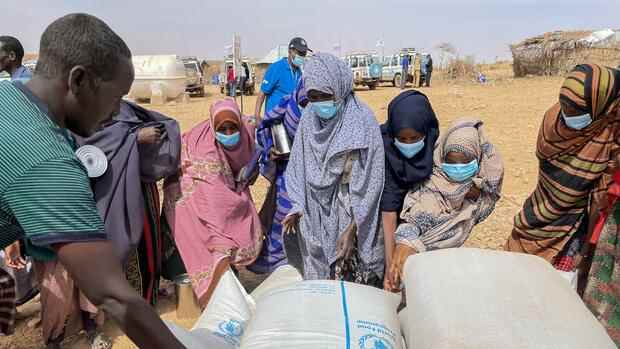Dusseldorf The war in Ukraine is driving the prices of essential foodstuffs to new highs worldwide. On the Paris futures exchange Matix, wheat futures exceeded the important mark of 350 euros on Wednesday, meaning that the grain is now more than twice as expensive as at the beginning of 2018. The prices for corn and oilseeds, i.e. plant seeds from which oil is extracted, keep climbing.
The trigger is the fear of a complete collapse in supplies from Russia and Ukraine. Exports from Ukraine are already largely disrupted because the Ukrainian ports on the Black Sea are closed and Russia is blocking sea transport routes.
Both countries are among the largest exporters of important agricultural goods, accounting for a good 30 percent of global wheat exports and a fifth of maize exports. Almost 80 percent of global sunflower oil supplies come from the Black Sea region.
With its huge acreage, the Ukraine alone is the fourth largest wheat exporter in the world. Traders on the agricultural exchanges fear that the disturbances in the war region will not remain the same. Western sanctions could also severely affect agricultural exports from Russia and their financial settlement.
Top jobs of the day
Find the best jobs now and
be notified by email.
The world would be affected differently. Direct effects can already be felt in the countries that obtain most of the wheat they need from Russia and Ukraine. These include Turkey and several North African countries such as Egypt and Tunisia.
Food is becoming scarce in many crisis regions
In North Africa in particular, poor people depend on an affordable supply of bread. Despite subsidies, a large part of the income is already spent there on food. The same applies to countries in western Asia. Nutrition experts are therefore warning of a food crisis that could lead to growing hunger and social tensions.
“Already, 276 million people in 81 countries are affected by acute hunger. The world simply cannot afford another conflict,” said Martin Frick, head of the United Nations World Food Program (WFP) in Germany. More than half of the food that the WFP distributes in crisis regions comes from Ukraine. “Putin’s war is not only bringing immeasurable suffering to Ukraine. The effects will be felt far beyond the region’s borders.”
>> Read about this: War in Ukraine drives food prices to record highs
Bayer boss Werner Baumann also warns of a food crisis caused by the war in Ukraine. This would primarily affect Africa and thus the “poorest regions of the world”, he said at the balance sheet press conference on Tuesday. In addition to the bottlenecks caused by the war, there are serious weather conditions in important agricultural areas, he added. In large parts of Latin America, for example, there has recently been a severe drought.
It is also feared that problems with the food supply could lead to social tensions in the Middle East and North Africa and further destabilize the political situation there. Egypt alone obtains a good 80 percent of its wheat requirements from Russia and Ukraine. Turkey buys 65 percent of wheat from Russia.
Agricultural experts assume that imports from Russia will fall permanently as a result of sanctions in the West. The countries are therefore looking intensively for a replacement. Romania, for example, offers itself as a supplier, after France the second largest wheat exporter in the European Union.
Lebanon has wheat reserves that, according to its own statements, are sufficient for a month at most. The country sources almost 60 percent of this grain from Ukraine and is currently in talks with the US and India about replacement supplies. Since the main wheat silos were destroyed in the huge explosion at the port of Beirut in 2020, the country has had very limited storage capacity.
Fears of inflation are growing in Europe
In Europe, the massive increases in prices on the world agricultural markets are likely to fuel inflation further. However, the authorities do not fear a supply bottleneck here because the EU is relying on a high level of self-sufficiency with wheat, the Federal Ministry of Agriculture announced. In addition, the EU Commission had already drawn up an emergency plan for security of supply before the war in Ukraine.
The German Farmers’ Association also believes that the quantities of grain required in the EU have been secured by the high level of self-sufficiency. But the association restricts: This will only continue to apply if the farmers have sufficient fertilizer available in the coming spring.
The fertilizer market is currently considered deserted because production was curtailed by many manufacturers last autumn and winter. The reason was the high price of natural gas, which made production no longer economical. Gas is used both as a raw material and as an energy supplier in the production of fertilizer products.
In addition, Russia is one of the leading global manufacturers of the fertilizer raw material ammonium nitrate. However, the country restricted exports last year and stopped them completely at the beginning of February in order to ensure that its own agriculture was supplied with fertilizer.
Whether the Russian export ban on this product will be lifted on April 1, as previously planned, remains to be seen. The Latin American countries in particular perceive a permanently restricted supply of fertilizers from Russia as a threat, because they obtain the nutrients for their huge agricultural areas primarily from Russian plants.
This is one reason why Brazil, for example, does not support Western sanctions against Russia and is taking a neutral stance in the conflict.
More: The global food crisis is getting worse – and bringing inflation and hunger


